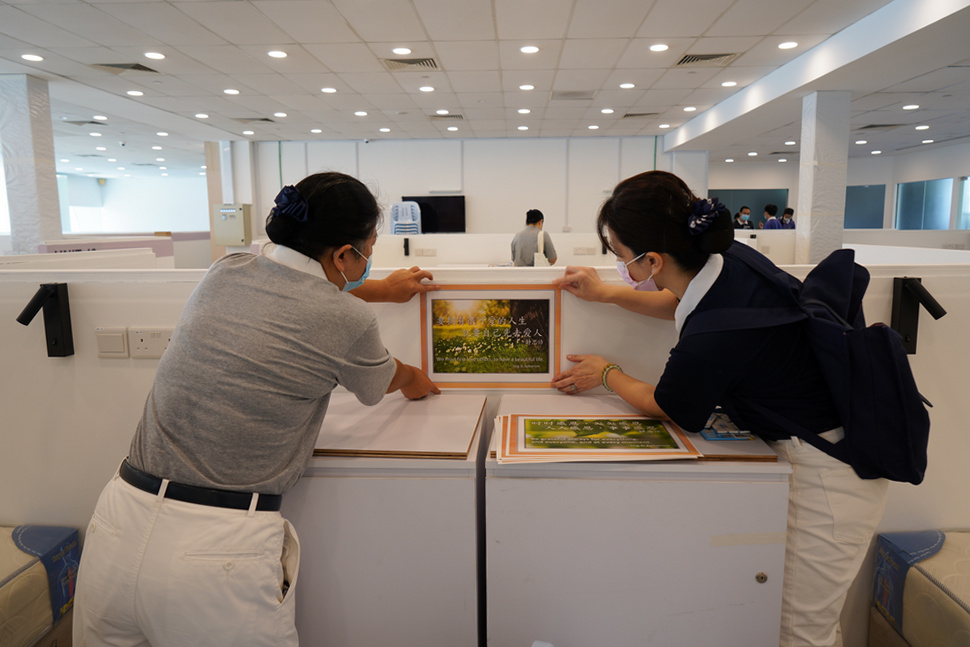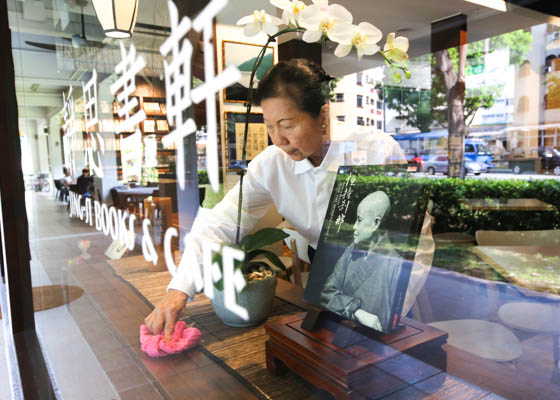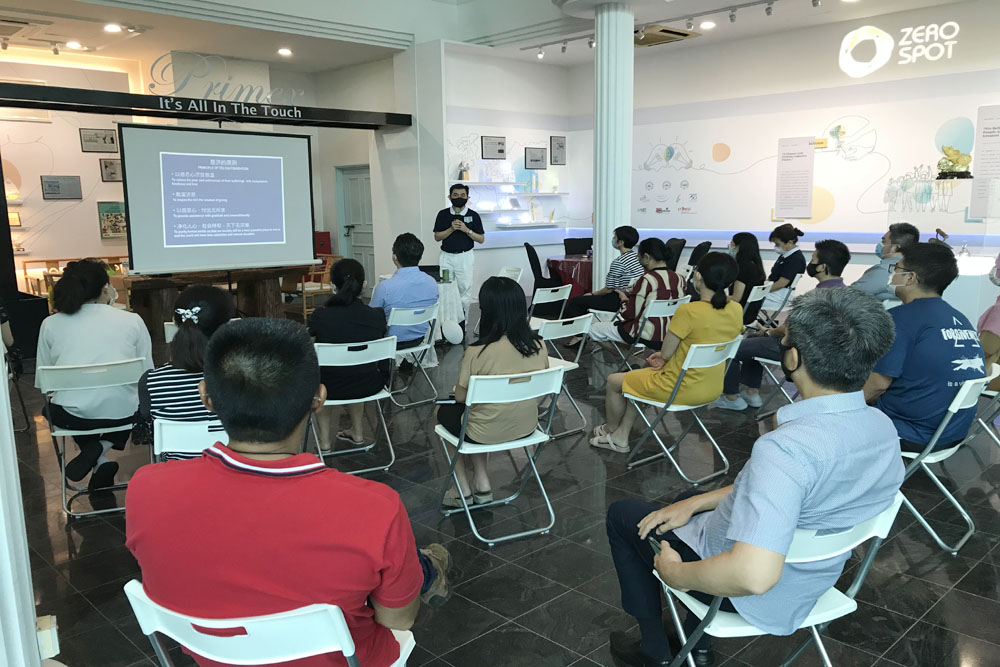During the volunteer briefing session at the Da Ai Gallery, volunteers serving as guides and community leaders listen attentively to the explanations of design and planning team member Seow Beng Lan and carefully take notes. (Photo by Chua Teong Seng)
At the Tzu Chi Da Ai Gallery, volunteers looked at the exhibits and touched them, smiles lighting up their faces as their memories of pieces of Tzu Chi’s history intermingled with the visual and tactile cues. Three pencil stubs, each 1-cm in length, and three cabbage props—can these seemingly puzzling exhibits really tell the story of Tzu Chi?
The Tzu Chi Da Ai Gallery officially opened to the public on 19 April 2016 and is situated at 137 Queen’s Avenue in Singapore. The exhibits are housed in an old standalone bungalow from Singapore’s colonial past. Known affectionately as a “black and white house”, such bungalows were originally built to house the colonial government’s officials.
With half a year of effort, the originally empty black and white house was transformed into an exhibition space rich with an air of humanistic culture. The planning team behind the Gallery, Mok Peng San and Seow Beng Lan, had arranged two weekend evening briefings for volunteers who would be serving as guides at the Gallery and community volunteer leaders, to explain the positioning, objectives, and the meaning behind the individual displays.
Training for the guides was especially crucial as they are seen as the most important “software” component of the project. The first briefing held on 10 April was attended by 39 volunteer guides while 19 Tzu Chi community leaders attended the second briefing a week later. The former CEO of Tzu Chi Singapore, David Liu, and the North Zone convenor of Tzu Chi’s honorary board members in Taipei, Taiwan, Chen Zhi Yuan, also visited during that period.
Before they stepped foot into the exhibition area, Seow explained the mission of the Gallery saying that Tzu Chi was approaching its 50th anniversary this year, and the Singapore chapter too, has had 23 years of long history behind its establishment. Yet locally, there are still many people who have not heard of the organization. Her wish was therefore to invite visitors to the Gallery, and introduce the world of Tzu Chi and the good that it undertakes for society to more people.
Creative Use of Space to Spread the Dharma
Volunteers arrived at the peaceful environs of Queen’s Avenue, a stark contrast to the hustle and bustle of the city, as evening fell. The fresh air in the surroundings is refreshing to the spirit, and the planning team capitalized on this by demarcating two zones on the ground level, the open-air space and the small storage area, into functional spaces where one could experience the serenity of nature.
Dharma begins at the doorway quite literally, as at the entrance, one sees a saying by Tzu Chi’s founder, Dharma Master Cheng Yen, written in both English and Chinese: “Walk gently to show our respect for the earth”. The lyrics of the Tzu Chi song “Holding All Sentient Beings Dear” are brought to mind, exhorting universal compassion for all, as well as Master Cheng Yen’s spirit of boundless compassion.
A tall bamboo coin bank that stands at the entrance introduces the beginnings of the organization to visitors who can choose to make a donation for charity here. Further in, the walls are adorned with information tracing Tzu Chi’s charitable footprints across the world. On the second level, there are various sections devoted to Tzu Chi’s history and its related stories, those of its Singapore chapter as well as happenings on the global front, and a multi-media area. With regards to the furniture used in the Gallery, most are recycled pieces, while others are remodelled works from the efforts of volunteers.
Tracing the Footsteps of Tzu Chi
Tzu Chi’s history began in 1937, the year Master Cheng Yen was born in Taiwan. Sections devoted to the organization’s history and Tzu Chi stories employ the use of multiple mediums and tangible exhibits, affording the visitor an experience of stepping backwards in time as they retrace the footsteps of the many pioneering individuals.
With the creative presentation of many items including a tile from the 921 Taiwan earthquake, the “rice bank” used in Myanmar, and even grass hats and cement bags brought over from Taiwan, volunteers being briefed soon abandoned their note-taking. Their attention thus focused on the exhibits, they could not help running their fingers over them and discussing their significance.
Just three bamboo coin banks was all it took to convey the story of how Tzu Chi’s charitable undertakings started; the austerity of monastic life was illustrated by a piece of salted bean curd, and three cabbages on display spoke of the organization’s past charitable beneficiary case files. A single thought of compassion for fellow human beings manifested in the construction of Tzu Chi’s “Great Love housing,” while sparing a kind thought for the suffering of others resulted in the production of various items, such as the eco-friendly blanket, the Tzu Chi instant rice, and its bone marrow donation initiative. Over the past 50 years in the organization’s history, there are an endless number of touching stories to be shared.
When Tzu Chi commissioner Lin Xiu Qing first heard about the Da Ai Gallery, she was filled with anticipation and attended the briefing session at the first opportunity. “Every corner (of the Gallery) speaks of the Dharma, (and) in every corner, you can feel the Great Love and compassion of the Master.”
Having been in Tzu Chi for some years, she understood that one has to be moved by one’s own reasoning first before one is able to touch the heart of others. The salted bean curd display prompted her to express the deep emotions it evoked in her: “(From knowing that) just one piece of salted bean curd* had to last a month; this tangible piece of food has come to symbolise the vast compassion of the Master.”
*A piece of salted bean curd was often the only dish Master Cheng Yen and her monastic disciples could afford in the early days of Tzu Chi.
Concern for Local Events with an Eye on the World
The different sections of the Gallery incorporate science and the creative use of multi-media to overcome the constraints of space and bring the story of Tzu Chi alive to visitors. With projection and touchscreen technology, visitors transcend geography and the global humanitarian efforts of Tzu Chi are made easily visible.
As denizens of the world, all of our lives are interconnected. The exhibition segment with the theme “Tzu Chi and world events” illustrates the philosophy behind the organization’s global development—that Tzu Chi will go to any part of the world where there is disaster.
The Nepal earthquake, refugee outreach in Europe, eco-friendly blanket and design of the multi-purpose foldable bed used in Tzu Chi’s humanitarian aid missions overseas, etc. are a testament to the five principles the organization abides by, namely directness, priority, respect, timeliness, and practicality. The seeds of love sown by volunteers and their example of showing kindness by example are also evident in the growing reach of the Tzu Chi missions.
The Gallery also brings the topic of protecting the earth to the attention of visitors, advocating their timely action to address the issue. Visitors can also use the QR code to view Koko the gorilla mascot on their smartphones urging them not to destroy the environment.
At the section focusing on Tzu Chi’s local presence, the map of Singapore on the wall aids in explaining how the organization can swiftly deploy its network of local volunteers in the community as needed. Employing the format of a mini lecture hall, this section has a big screen and 12 seats which though appearing new, are actually recycled pieces of discarded furniture picked up from the Tzu Chi recycling point. Even the screen which is used to present an introduction to Tzu Chi Singapore, is a recycled item that has been given a new lease of life. A touchscreen placed at the back maps out the milestones in the local chapter’s history, showing its transition from the early days at the Poh Kwan Foh Tang temple, to its current day location at Pasir Ris, where the Jing Si Hall now stands.
The multi-media experiential station at the Gallery has a collection of quality Da Ai TV station programmes for visitors’ viewing. All in all, careful planning has been done so that visitors can stop to contemplate the beauty and meaning in life away from the usual hustle and bustle.
Lai Shu Fan, volunteer leader of South Zone, had her attention drawn to the words on the floor “walk gently to show our respect for the earth” the moment she stepped in. She described the Gallery as a place where one could rest one’s weary spirit and rediscover direction in life and will encourage other Zone leaders to bring their team members along for a visit.
History is such that if one does not record it down and propagate it, it will be buried in the sands of time. With the inauguration of the Gallery, it is hoped that more Singaporeans and overseas visitors can get to know the truth, beauty and goodness in the works of Tzu Chi and be inspired to higher spiritual ideals. In addition, through the exhibits, others can have a better understanding of Tzu Chi’s core values and be drawn to the same missions. Just as CEO of Tzu Chi Singapore Low Swee She has said, the wholesome teachings of Tzu Chi must be spread far and wide through the generations.



